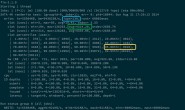前面一篇文章提到大数据开发-Spark Join原理详解,本文从源码角度来看cogroup 的join实现
1.分析下面的代码
import org.apache.spark.rdd.RDD
import org.apache.spark.{SparkConf, SparkContext}
object JoinDemo {
def main(args: Array[String]): Unit = {
val conf = new SparkConf().setAppName(this.getClass.getCanonicalName.init).setMaster("local[*]")
val sc = new SparkContext(conf)
sc.setLogLevel("WARN")
val random = scala.util.Random
val col1 = Range(1, 50).map(idx => (random.nextInt(10), s"user$idx"))
val col2 = Array((0, "BJ"), (1, "SH"), (2, "GZ"), (3, "SZ"), (4, "TJ"), (5, "CQ"), (6, "HZ"), (7, "NJ"), (8, "WH"), (0, "CD"))
val rdd1: RDD[(Int, String)] = sc.makeRDD(col1)
val rdd2: RDD[(Int, String)] = sc.makeRDD(col2)
val rdd3: RDD[(Int, (String, String))] = rdd1.join(rdd2)
println(rdd3.dependencies)
val rdd4: RDD[(Int, (String, String))] = rdd1.partitionBy(new HashPartitioner(3)).join(rdd2.partitionBy(new HashPartitioner(3)))
println(rdd4.dependencies)
sc.stop()
}
}
分析上面一段代码,打印结果是什么,这种join是宽依赖还是窄依赖,为什么是这样
2.从spark的ui界面来查看运行情况
关于stage划分和宽依赖窄依赖的关系,从2.1.3 如何区别宽依赖和窄依赖就知道stage与宽依赖对应,所以从rdd3和rdd4的stage的依赖图就可以区别宽依赖,可以看到join划分除了新的stage,所以rdd3的生成事宽依赖,另外rdd1.partitionBy(new HashPartitioner(3)).join(rdd2.partitionBy(new HashPartitioner(3))) 是另外的依赖图,所以可以看到partitionBy以后再没有划分新的 stage,所以是窄依赖。
3.join的源码实现
前面知道结论,是从ui图里面看到的,现在看join源码是如何实现的(基于spark2.4.5)
先进去入口方法,其中withScope的做法可以理解为装饰器,为了在sparkUI中能展示更多的信息。所以把所有创建的RDD的方法都包裹起来,同时用RDDOperationScope 记录 RDD 的操作历史和关联,就能达成目标。
/**
* Return an RDD containing all pairs of elements with matching keys in `this` and `other`. Each
* pair of elements will be returned as a (k, (v1, v2)) tuple, where (k, v1) is in `this` and
* (k, v2) is in `other`. Performs a hash join across the cluster.
*/
def join[W](other: RDD[(K, W)]): RDD[(K, (V, W))] = self.withScope {
join(other, defaultPartitioner(self, other))
}
下面来看defaultPartitioner 的实现,其目的就是在默认值和分区器之间取一个较大的,返回分区器
def defaultPartitioner(rdd: RDD[_], others: RDD[_]*): Partitioner = {
val rdds = (Seq(rdd) ++ others)
// 判断有没有设置分区器partitioner
val hasPartitioner = rdds.filter(_.partitioner.exists(_.numPartitions > 0))
//如果设置了partitioner,则取设置partitioner的最大分区数
val hasMaxPartitioner: Option[RDD[_]] = if (hasPartitioner.nonEmpty) {
Some(hasPartitioner.maxBy(_.partitions.length))
} else {
None
}
//判断是否设置了spark.default.parallelism,如果设置了则取spark.default.parallelism
val defaultNumPartitions = if (rdd.context.conf.contains("spark.default.parallelism")) {
rdd.context.defaultParallelism
} else {
rdds.map(_.partitions.length).max
}
// If the existing max partitioner is an eligible one, or its partitions number is larger
// than the default number of partitions, use the existing partitioner.
//主要判断传入rdd是否设置了默认的partitioner 以及设置的partitioner是否合法
//或者设置的partitioner分区数大于默认的分区数
//条件成立则取传入rdd最大的分区数,否则取默认的分区数
if (hasMaxPartitioner.nonEmpty && (isEligiblePartitioner(hasMaxPartitioner.get, rdds) ||
defaultNumPartitions < hasMaxPartitioner.get.getNumPartitions)) {
hasMaxPartitioner.get.partitioner.get
} else {
new HashPartitioner(defaultNumPartitions)
}
}
private def isEligiblePartitioner(
hasMaxPartitioner: RDD[_],
rdds: Seq[RDD[_]]): Boolean = {
val maxPartitions = rdds.map(_.partitions.length).max
log10(maxPartitions) - log10(hasMaxPartitioner.getNumPartitions) < 1
}
}
再进入join的重载方法,里面有个new CoGroupedRDD[K](Seq(self, other), partitioner)
def join[W](other: RDD[(K, W)], partitioner: Partitioner): RDD[(K, (V, W))] = self.withScope {
this.cogroup(other, partitioner).flatMapValues( pair =>
for (v <- pair._1.iterator; w <- pair._2.iterator) yield (v, w)
)
}
def cogroup[W](other: RDD[(K, W)], partitioner: Partitioner)
: RDD[(K, (Iterable[V], Iterable[W]))] = self.withScope {
if (partitioner.isInstanceOf[HashPartitioner] && keyClass.isArray) {
throw new SparkException("HashPartitioner cannot partition array keys.")
}
//partitioner 通过对比得到的默认分区器,主要是分区器中的分区数
val cg = new CoGroupedRDD[K](Seq(self, other), partitioner)
cg.mapValues { case Array(vs, w1s) =>
(vs.asInstanceOf[Iterable[V]], w1s.asInstanceOf[Iterable[W]])
}
}
/**
* Return an RDD containing all pairs of elements with matching keys in `this` and `other`. Each
* pair of elements will be returned as a (k, (v1, v2)) tuple, where (k, v1) is in `this` and
* (k, v2) is in `other`. Performs a hash join across the cluster.
*/
def join[W](other: RDD[(K, W)], numPartitions: Int): RDD[(K, (V, W))] = self.withScope {
join(other, new HashPartitioner(numPartitions))
}
最后来看CoGroupedRDD,这是决定是宽依赖还是窄依赖的地方,可以看到如果左边rdd的分区和上面选择给定的分区器一致,则认为是窄依赖,否则是宽依赖
override def getDependencies: Seq[Dependency[_]] = {
rdds.map { rdd: RDD[_] =>
if (rdd.partitioner == Some(part)) {
logDebug("Adding one-to-one dependency with " + rdd)
new OneToOneDependency(rdd)
} else {
logDebug("Adding shuffle dependency with " + rdd)
new ShuffleDependency[K, Any, CoGroupCombiner](
rdd.asInstanceOf[RDD[_ <: Product2[K, _]]], part, serializer)
}
}
}
总结,join时候可以指定分区数,如果join操作左右的rdd的分区方式和分区数一致则不会产生shuffle,否则就会shuffle,而是宽依赖,分区方式和分区数的体现就是分区器。
吴邪,小三爷,混迹于后台,大数据,人工智能领域的小菜鸟。
更多请关注





